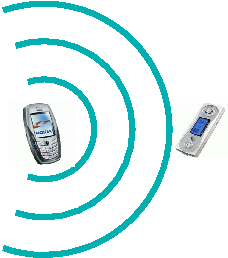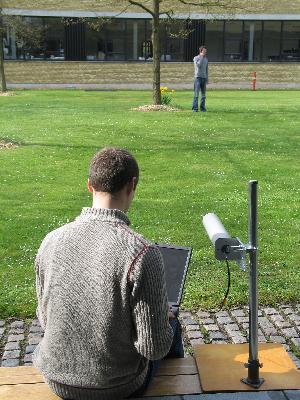Bluetooth security

What is Bluetooth?
Bluetooth is a technology intended particularly for use in wireless
communication between pieces of electronic apparatus which are
separated by relatively small distances (typically up to a few
meters). The basic motivation for this is to avoid the use of cables
for connecting devices, particularly mobile devices which need to be
moved from place to place.
Typical examples of devices which use Bluetooth are mobile phones,
PDAs, portable and stationary computers, medical apparatus, and all
sorts of equipment which might be attached to these, such as
headphones, microphones, printers, sensors and so on.
Bluetooth devices communicate with one another using a range of
frequencies around 2.4GHz, within the so-called ISM (Industrial,
Scientific and Medical) band. This band is also used by a lot of
Wireless LAN (WiFi) equipment, by microwave ovens, and for many other
purposes.
As Bluetooth devices are only intended to communicate over small
distances, the power of the transmitter in a Bluetooth device is
typically very small. There are in fact three classes of Bluetooth
device, with different ranges for transmission:
| Class | Power (mW) | Range (m) |
|---|
| 1 | 100 | 100 |
| 2 | 2.5 | 10 |
| 3 | 1 | 0.1-10 |
Most pieces of apparatus which use Bluetooth technology are equipped
with a non-directional antenna, which is used both for sending and
receiving wireless signals. Essentially, this means that any other
Bluetooth equipment within range of the transmitter can receive the
signals. The ranges given in the table above are estimates based on
typical Bluetooth antennas in small standard pieces of apparatus. It
is important to realise that with special equipment, the signals can
be picked up over much larger distances, maybe as large as 2-3
kilometers!
Bluetooth security
Since any equipment within range of a Bluetooth transmitter can in
principle receive the transmitted signals, precautions need to be
taken to prevent signals from being used by anyone except the intended
receiver(s). Although each Bluetooth device is identified by an
address (in fact just a number between 0 and 248-1), which
is used to indicate the intended receiver of a transmitted message,
there is no guarantee that other devices cannot pick up the message
simply by eavesdropping. Three mechanisms are available to prevent
this:
- Bonding, by means of which two
devices can produce a shared secret, which only those two devices
know.
- Authentication, by means of which
two or more devices can verify one another's identities.
- Encryption, by means of which
two devices can achieve confidentiality of an exchange of messages by
ensuring that third parties cannot understand the messages.
Bluetooth security modes and profiles
Bluetooth devices can operate in three security modes which
exploit various combinations of these mechanisms:
- Security mode 1: A device in this mode will use no
security procedures.
- Security mode 2: Services and applications which are
accessed via Bluetooth can specify whether authentication and/or
encryption are to take place.
- Security mode 3: The device will itself determine whether
authentication and/or encryption are to be used whenever it sets up a
Bluetooth connection to another device.
In security modes 2 and 3, it is possible to specify a security
policy, such that only particular devices have access to
particular services.
Yet another possibility is to define Bluetooth profiles, which
utilise combinations of the basic mechanisms in order to achieve a
level of security which is thought to be appropriate for particular
applications. For example, profiles might be defined for use in:
- Transferring data files between Bluetooth devices;
- Supporting the use of headsets;
- Transferring so-called objects such as business cards
("vCard objects") or calendar entries ("vCalendar objects").
A typical Bluetooth device is set up to support a number of profiles
appropriate to its functionality. This may lead to security problems
if the device has some functions which do not require a high level of
security, since these functions will typically be supported by low
security profiles. A well-known example is the object push
profile used to support transfer of objects. In this profile,
authentication is not used before the objects are exchanged, and this
deficiency can be exploited by intruders who want to attack Bluetooth
devices in which the profile is installed.
What are the security risks?
There are a number of built-in weaknesses in the way in which
Bluetooth operates:
- The basic identification of a Bluetooth device is an address.
This can easily be faked, so one device appears to be another.
- The authentification and encryption processes both use relatively
simple methods to generate the required messages from secrets
shared by the two participants. By monitoring the communication
over a long period, it may be possible to deduce the secrets, and
thus be able to find out how to fool the authentification
procedure or decrypt the encrypted messages.
These weaknesses are in practice relatively difficult to exploit for
real attacks. Faking the address is no help to the attacker, as long
as the devices use correct Bluetooth authentication. Deducing the
secrets from the passing communication is not really a realistic
possibility, as you need an extremely powerful computer to perform the
necessary analysis, which in the "cheapest" case requires
264 (about 16 billion billion) arithmetic operations.
Thus most actual attacks on Bluetooth devices are based
on other approaches:
- Users' laziness: Bonding requires the same PIN code to
be supplied simultaneously to the two devices which are to be
bonded. In devices in which this is done by hand, the procedure
is rather troublesome and the user is therefore often tempted to
choose very short PIN codes or simple values which are easy to
guess (such as 0000). In this way it becomes easy for others to
find the right PIN code by trial and error.
- Weak profiles: Profiles such as object push do
not require devices to perform the authentication process. This
can be exploited in some telephones, in order to get hold of
information stored in the victim's telephone, such as the
telephone book, stored text (SMS) messages, contact lists etc. A
particularly well-known attack of this type is
Bluesnarfing.
- Unprotected services: Some models of telephone do not
have proper access control on services accessible via
Bluetooth. A well-known attack of this type is
Bluebugging,
in which an attacker can set up a connection to the victim's
telephone without authentication and without the victim in any
way being involved in the process. Via this hidden connection,
the attacker can subsequently send so-called AT commands
to the victim's telephone, which makes it possible to make calls,
read and write text messages, make connections to the Internet or
even eavesdrop on the victim by getting the victim's telephone to
dial secretly to the attacker's telephone.
- Fake bonding (1): The attacker establishes a
relationship of trust by means of the bonding mechanism, but
arranges for the connection no longer to be visible in the
victim's list of bonding partners. In this way the attacker
becomes able to carry out other security procedures, set up
connections and so on, on the victim's telephone without the
victim being aware of this. Essentially the attacker has
established a backdoor to the victim's telephone, via
which it becomes possible to obtain access to the victim's
texting service, Internet service etc.
This attack in fact also makes it possible to perform
Bluesnarfing on devices which would otherwise refuse Bluesnarf
attacks.
- Fake bonding (2): This attack also exploits the bonding
mechanism, but this time in a way known as Bluejacking,
in which the victim must participate if the attack is to have any
effect with respect to security.
The attacker initiates the bonding process. This will, as usual,
lead to a query being displayed on the victim's telephone, asking
whether it is OK to set up a connection. However, the attacker
exploits the feature that a relatively long text can be sent and
displayed together with the rest of the query. Users often
exploit this feature to send one another small, anonymous
messages, which in itself is a relatively innocent pastime. The
security problem arises if the attacker can get the victim to
accept the connection, by giving some spurious reason in
the message; the attacker then has free access to the victim's
telephone.
- Malicious programs: Just as in computers in general,
Bluetooth devices can be exposed to attacks by vira, worms and
similar malicious programs, which in this case are spread by
means of Bluetooth communication.
What can you do to protect yourself?
Some simple rules can help a lot to reduce the risks inherent in the
use of Bluetooth:
- Turn Bluetooth off, unless you actually need to use it!
- Set your Bluetooth device up, so it runs in hidden
mode. The device will then not send out signals which draw
attention to its existence. Such signals can otherwise be used
by attackers to find out whether there are potential victims in
the vicinity.
- Make sure your device has the latest version of the internal
firmware. Many of the attacks mentioned above only work
on telephones which have some kind of design fault in their
electronics or the associated software. Many phone manufacturers
offer upgrades which reduce the possibilities of attack
considerably.
- Choose good, long PIN codes. The value 0000 is probably
the value which the attacker is most likely to try first. Choose
something better, preferably with more digits. Or use devices
where the exchange of PIN codes can be done automatically.
- Make sure your device has the necessary antivirus
software, when this is relevant.
- Take care when installing Bluetooth applications with new
profiles whose origin you are unsure about. They might
contain security holes which can be exploited by an attacker.
- Only allow bonding to take place with devices which you consider
to be trustworthy. Always say no to surprising offers
which will cause a Bluetooth connection to be set up to your
device from other devices which you do not know.
Further information
For the technically interested person, there are lots of much more
technical descriptions of Bluetooth security, most of them in English.
A good web page, with detailed references, can be found at:
http://www.niksula.cs.hut.fi/~jiitv/bluesec.html.
An overview of some of the best-known attacks and a list of some models
of telephone which are particularly at risk, can be found at:
http://www.thebunker.net/security/bluetooth.htm.
Robin Sharp
Last updated 050518.




